The pike is an extremely exciting fish to target; it is fast, aggressive, it likes to eat a lot, and it can reach a pretty substantial size. All these features make the pike the ultimate predator and game fish.
As the northern pike can also be a pretty intimidating and difficult species to fish for, especially for beginners, I went ahead and wrote this helpful article filled with my very best pike fishing tips that I have gathered over a period of more than 20 years.
If you follow these basic tips, you will start to catch lots of pike in no time, guaranteed!
Gear And Tackle Tips for Pike Fishing
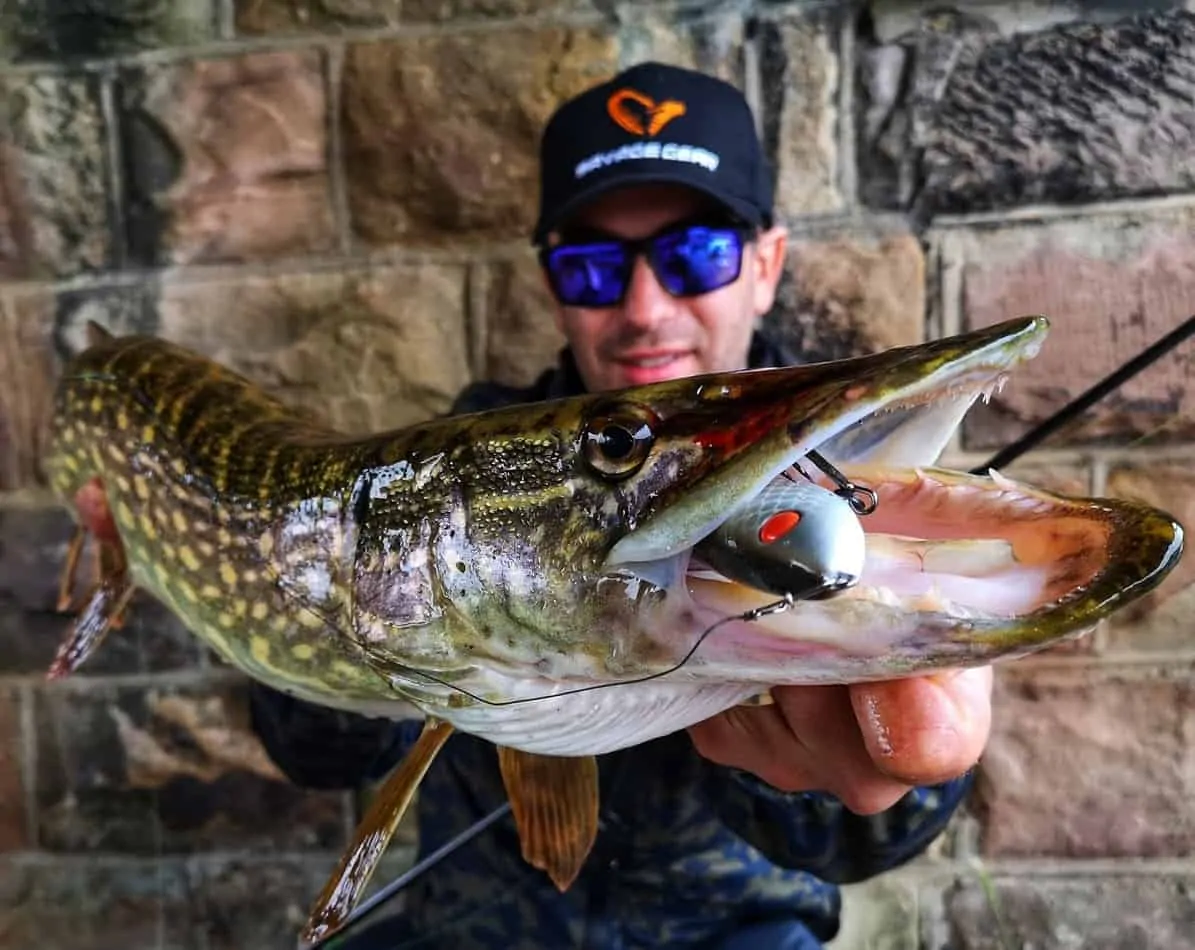
1. Start with conventional spinning rods
There is plenty of high-end pike gear out there and you can end up spending a fortune on various rods, but you really don’t have to.
Most pike fishing can be done with a conventional spinning rod and if you are just starting out, that’s exactly the type of rod you should get.
This species does not demand a high level of finesse, and in my opinion, it’s much more important to learn all the basics of pike fishing when you are new to the sport. Start simple and learn as much as you can. You can gear up later on if you feel the need to do so.
A medium-heavy action spinning rod of around 7ft is a perfect fit for most pike lures. For lighter trolling, float, and or fishing, a somewhat longer heavy action spinning rod of 8-9ft will definitely suffice to start off with.
Just make sure you are buying rods with a decent backbone. It will help you cast further and get more control over a fighting fish. Check out my favorite pike spinning rod on Amazon here.
2. Buy a spinning reel and a baitrunner with a few ball bearings
The same logic applies to fishing reels; there are literally hundreds of reels out there and many of them cost a lot of money and have features that you don’t really need.
Get yourself a qualitative spinning reel and baitrunner with at least 3-4 steel ball bearings and you are good to go.
Ball bearings are used to reduce the rotational friction of your reel. They simply make the reeling in more smoothly, something that is especially important when it comes to spin fishing, as you are casting out and reeling in quite a lot.
Your spinning reel (used for lure fishing) should have a line capacity of about 200 to 250 yards of 25 to 30lb braid. You can find a great spinning reel for pike fishing on Amazon here.
Your baitrunner (used for live and dead baiting, as well as for trolling) should be able to hold around 200 to 250 yards of 15 to 18lb mono.
Pro Tip: Baitrunner, or baitfeeder reels have a second drag system, which can be very helpful when fishing for pike on the bottom, as tip #37 will explain in more detail.
3. Use strong enough mainline
Pike can be really strong and aggressive fighters, which is why you need a mainline that can handle their violent head shakes and fast runs.
When it comes to monofilament line (used mainly for trolling and fishing with live baits), a mainline with a 15-20lb test is a perfect fit for pike fishing.
If you are using braided mainline (primarily used for spinning and dead baiting), a 25-30lb test is a solid choice for pike.
RELATED ARTICLE: Need tips on the best mainline for pike (both mono and braid)? Then make sure to also check out this article I wrote!
4. Get a big landing net
Pike are big fish and you don’t want to end up with a net that is too small for a big catch. Many anglers have lost big pike right at their feet due to a net that the fish just wouldn’t fit into.
A big game landing net may look gigantic, but it’s gonna be just right for those big, fat pike mammas!
Many anglers also use big rubber mesh landing nets for pike. They make unhooking a fish very easy, as the treble hooks will not get tangled in the rubber mesh.
5. Buy a simple unhooking mat
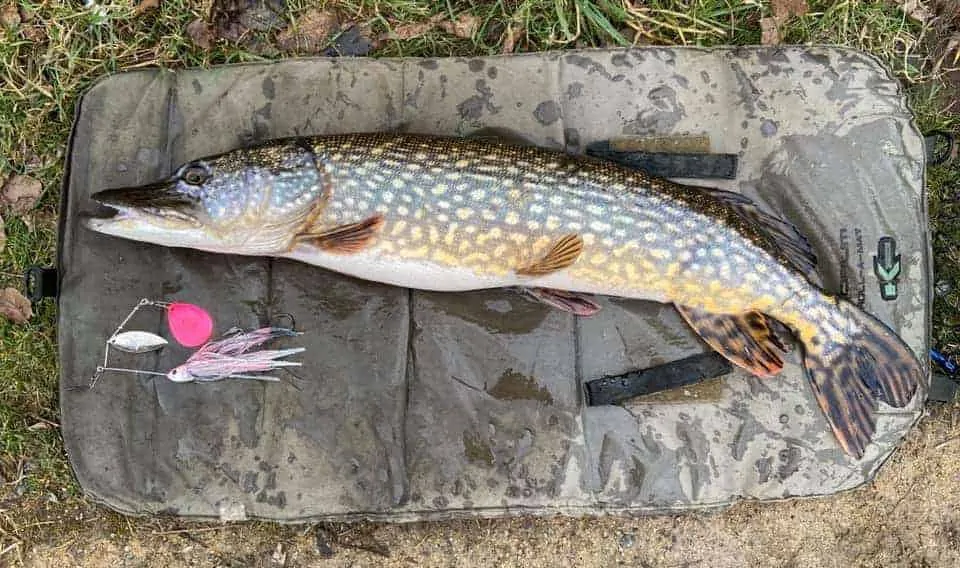
An unhooking mat makes handling the fish on land so much easier and protects the pike’s vulnerable skin and slime layer.
To start with, a thin and foldable mat of about 3-4 feet will totally suffice. Such mats are quite cheap and very easily transported, which makes them the perfect fit for the mobile pike angler.
6. Buy a couple of banksticks
If you want to do some ledgering or float fishing for pike, a couple of conventional 2-3 feet long banksticks can be very helpful on the bank.
They act as a rod rest and, if you also get a couple of butt grips, keep your rod(s) from being dragged into the water by a big and strong pike.
7. Also buy a couple of basic bite alarms
If you are fishing with more than one rod and/or in poor light conditions, electronic bite alarms will be your best friend when it comes to bite detection.
Not only do they sound when there is a bite, but they also have small, very bright LED lights for visual bite indication. This way, you will instantly know which rod to pick and strike with. See my go-to bite alarms for live and dead bait fishing on Amazon here.
8. Use wire leaders
The very best choice for pike leaders is, without a doubt, wire traces. If you are using wire, the risk of a bite-off is extremely low, always!
I recommend using modern titanium leader material, as it is ultra-strong and very soft and smooth. This type of wire can be used both for lures and baitfish.
In fact, it is so soft that you can literally knot it, which erases the need for loops and crimps altogether! Personally, I find this very convenient and time-saving!
For pike, you should use a wire leader of at least 25-30lb test that has a minimum length of 10 inches for spin fishing and 15 inches for live and dead baiting.
RELATED ARTICLE: Make sure to also read this in-depth article on the best wire leaders for northern pike
9. Use very thick fluorocarbon leaders
Many anglers prefer to use fluorocarbon leaders instead. Wire is of course the best and safest choice, but the right fluorocarbon leader can do a decent job as well!
There are however two very important things to remember when using fluoro:
- use an extremely thick line diameter (0.80-1.00mm)
- frequently check your FC leader for weak points
If you keep that in mind, you can reduce the risk for bite-offs significantly.
10. Buy a dozen lures and a couple of pike floats
Now that you have all the necessary gear and end tackle to start your pike fishing adventures, you just have to grab a couple of pike lures and floats before it’s time to head out to the bank.
Go to the store or check around online and get the following:
- Two 10g pike floats
- Two 20g pike floats
- 4 different kinds of crankbaits (4-8 inches)
- 4 inline spinners (size 5)
- 4 spoons (1/2-1 ounce)
That’s it, really! This package will serve you well as a beginner and can most certainly catch you your first pike.
If you’re after more detailed and advanced tips on the best pike gear, make sure to also check out the recommended gear page!
Now, let’s move on to the best time and location tips for pike fishing!
Where And When to Catch Pike
11. Fish close to vegetation
Pike love all types of vegetation. This they do for two simple reasons:
- they offer them a perfect ambush point
- smaller fish that the pike prey on keep close to vegetation as well
When starting a session, always go for the areas with the following types of vegetation first:
- reeds
- lily pads
- weeds (chickweed, pondweed)
- grass
- overhanging trees and bushes
12. Fish close to the margins
This often goes hand-in-hand with the vegetation tip. Shallower areas near the margins often hold more vegetation, are warmer, and offer better protection and ambush points.
Pro Tip: Especially in the dark, keeping close to the margins can be worth more than gold when it comes to pike fishing!
13. Fish during the early morning
Pike are very active during the early hours of the day, especially during summer, when the days are getting too warm. Getting up early can definitely pay off.
Try to be at the water just before first light and fish into the dawn, more often than not, you will experience a lot of activity and get plenty of bites.
Just don’t forget to bring some coffee with you to wake you up a little!
RELATED ARTICLE: Best Time of Day for Pike Fishing (All Four Seasons)
14. Also fish in the evening
The period around dusk is another golden time to catch pike. The dwindling light gives the predators extra cover and creates the perfect hunting environment.
Smaller fish also tend to get more active during these late hours of the day and become less careful. It is now that pike can get into a real feeding frenzy.
Make sure to be on the bank inf and when that evening feast is about to happen.
15. Try night fishing (but be well-prepared)
Night fishing for pike can also be extremely rewarding and this type of fishing is very exciting as well.
During the night, pike often feed and rest in shallower water, which is why you should, once again, try to hit the margins and shallower areas just off the shore.
However, night fishing takes some getting used to and demands a lot of preparation.
Read this related article I wrote in order to get all the information and details on how to fish at night the right way: Night fishing for Pike (Most Successful Tactics)
16. Prioritize mild and cloudy days
Pick days with favorable weather conditions in order to increase your chances of catching.
If you are new to fishing, a few early catches will boost your motivation immensely and you will want more after that, as opposed to blanking session after session and perhaps even giving up this wonderful hobby.
Desirable weather conditions for pike include:
- clouds
- light drizzle
- south or south-western winds
- mild temperatures
- pre-storm fronts
- sudden shifts from high to low pressure
17. Fish over the drop-offs (lakes)
This is a great tip for the colder months of the year, as you will often find large schools of baitfish over the drop-offs in lakes when the water is cold.
Naturally, the pike will follow these schools and lurk in the near vicinity.
You can fish over drop-offs that are close to the shore from land or try to target the ones that are further out if you have a boat.
Make sure to cover both the shallow and the deep edge of the drop-offs! Using a castable fish finder can help you find underwater features such as drop-offs. You can find a great and decently priced fish finder on Amazon here.
18. Hit the deep backwaters (rivers)
In rivers, deep and calm backwaters are the place to be for pike, especially during winter and early spring when the river water is cold, the current is stronger and the fish have to gather energy for the upcoming spawning season.
Backwaters are best fished with the float and a live baitfish, or with dead bait on the ledger.
19. Troll over open, deep water (lakes)
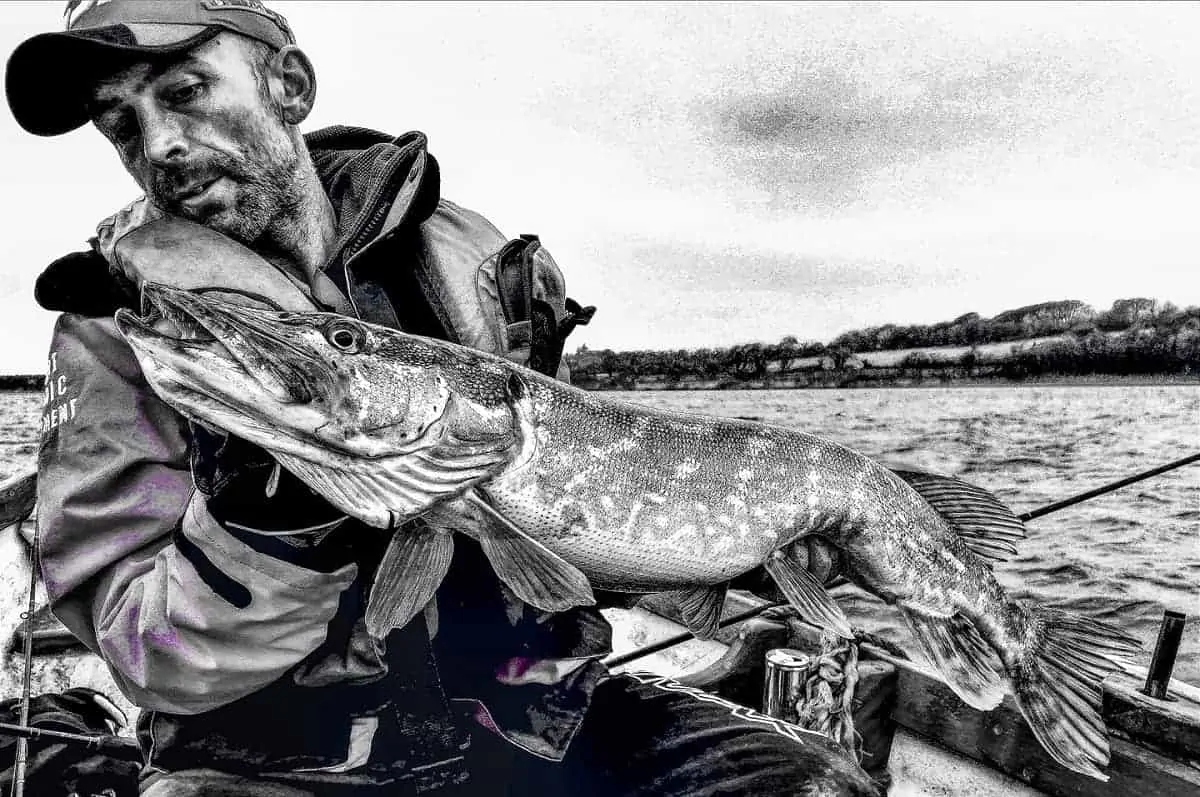
In bigger lakes, trolling over a larger depth can be absolutely deadly when it comes to catching big pike.
These larger specimens do not need the cover of the shallower water areas. Instead, they confidently hunt in open water and can be found at various depths out there.
Try trolling with larger crankbaits that can dive deep or slow-trolling a float with a tasty live bait.
20. Ice fish during daytime
Ice fishing for pike is best done during the day. For one thing, ice fishing in the dark is really not that good, as the pike tend to be rather inactive when the light’s gone.
For another thing, it is much safer to be on the ice during the day; you can scan the ice much better and there are most likely other people around. Security first, always!
If you want to get valuable tips on how to catch pike on the ice, you should also check out this related article: The Best Way to Ice Fish for Northern Pike
Spin Fishing Tips for Pike
21. Start off with basic lures and get a feeling for them
As tip #10 mentioned, you should start off with basic lures that have proven to catch a lot of pike and that can be presented relatively easily. They also have the advantage of not costing too much money.
Crankbaits, spoons, and inline spinners have been catching pike for hundreds of years and they continue to do so to this day. And they will enable you to learn a whole lot about lure fishing!
22. Use braid over monofilament mainline
Braided line actually offers a lot of advantages to beginners. The most prominent of them include:
- braided line stretches less, which gives you more control over your lures and lets you feel a bite much better
- it is more abrasion-resistant than monofilament
- it can cut better through vegetation
- braid is stronger, as it is thinner than monofilament of the same test pound. This also means that you can fit more line on your reel
23. Use swivels to avoid line twists
Always use a swivel to connect your mainline with your leader. It will prevent your line from twisting when retrieving your lures.
This is especially important when using rotating spinners. The swivel will also give your tackle a much better presentation.
24. Adjust your reel’s drag system
Spinning reels have a front drag and it is arguably the most important feature of your reel.
The drag system lets you determine how much or how little line a fish can take and acts as a buffer and protection against line breaks. Use it wisely!
Set it before you start fishing so that a fish can take some line if too much pressure is applied to it (test this by pulling your line with your hand). During a fight, adjust it frequently according to the fish’s movements and strength.
25. Avoid fishing too close to snags
As tip #11 mentioned, fishing near vegetation is always a good idea. However, fishing too close to reeds, weeds, and snags could result in a lure loss!
Instead, try to keep a distance of a couple of yards between your lure and any type of snags. A hungry pike will certainly not mind swimming that extra yard or two in order to get to his prey.
26. Accept the occasional loss of a lure
However careful you are going to cast though, you will most certainly lose the occasional lure to a snag or the bottom.
Just accept it and move on, it’s not the end of the world, even though it may feel like that when it happens.
With time, you will get much better at aiming and casting and will hence lose fewer lures and money!
27. Keep your lures away from the bottom
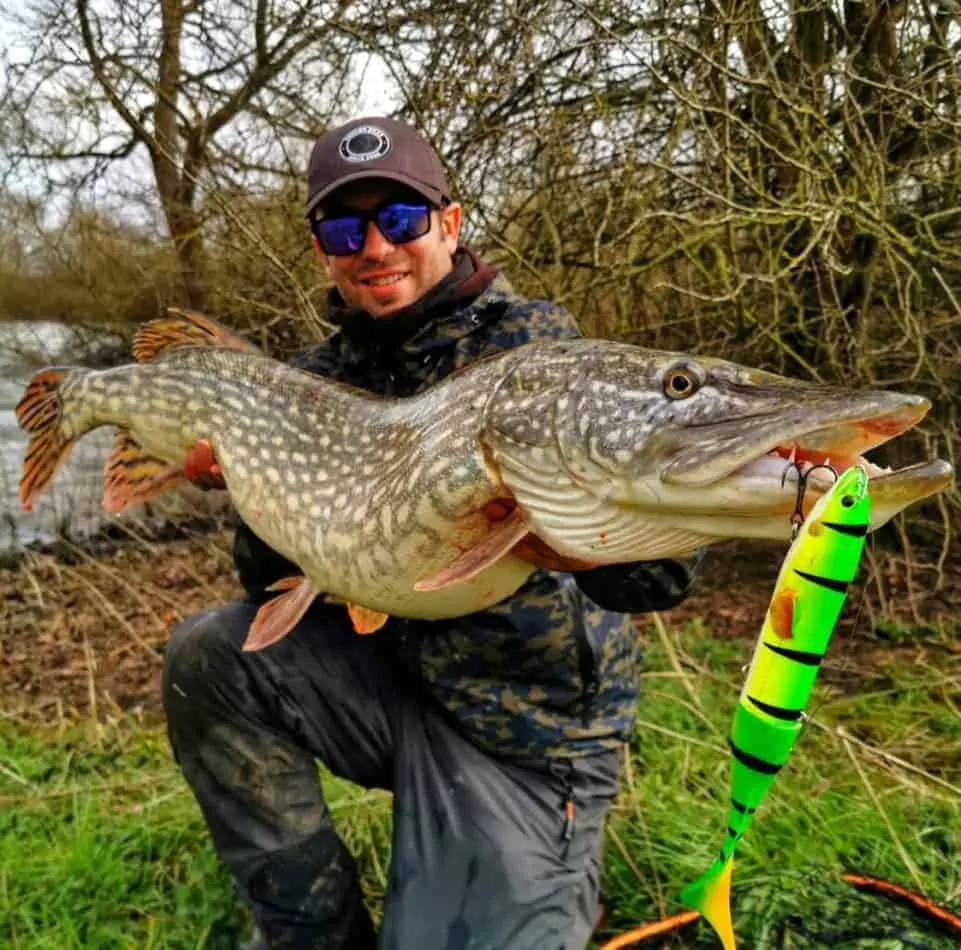
You will want to stay away from the bottom somewhat when fishing with lures such as spoons and inline spinners. They have a tendency to get hooked and hence lost.
If you are not fishing over a super even and clean lake or river bottom, something that is very difficult to know by the way, then make sure you fish your lures somewhat off the bottom, so that you don’t lose them to a sunken tree, a big stone, roots or other snags.
You can easily do so by retrieving your lure evenly and just a little faster than you normally would, so that it’ll keep roughly the same depth while it’s underwater.
28. But do not retrieve your lure too speedily either
However, do not reel in your lure too fast either, because then you could end up fishing it at a completely wrong depth where the fish won’t even notice it.
If your lure keeps breaking the surface or staying just below it, you know that you are retrieving it too fast.
Simply slow down a bit and try to find that perfect balance of speed.
29. Use crankbaits for trolling
As tip #10 suggested, getting a few crankbaits can be a very good idea when it comes to pike fishing, especially for trolling.
Crankbaits can both dive deep and will give you the very best presentation when trolling or slow-trolling them behind a boat. Something that you simply cannot achieve by using other types of lures. Check out my favorite crankbait for trolling monster pike on Amazon here.
30. Try different lure sizes
As tip #10 suggested, using different types of lures is always a winning concept. But you should also try different sizes of the same lure.
On some days, a big and bulky 1.5-ounce spoon might be the lure that gets you the most bites by far, while on other days, a much smaller and lighter spoon might be needed in order to lure the pike.
You just never know what bait size the fish prefer on any given day, which is why it is a good idea to have a variety of sizes (as well as shapes and lure types) with you.
Live And Dead Bait Tips for Pike
31. Catch your live bait in advance
When you are planning to fish with live bait, make it a priority to catch your baitfish before you start your session.
Either head out and catch a bunch of shiners, roaches, or shads a day or so in advance or plan a few extra hours before you start fishing for pike just to catch those baits.
In either case, you can keep them alive in a big bucket or container filled with fresh, cold water and a small oxygen pump. During your session, you can store your live bait in a keepnet as well.
Do not make the mistake and try to catch your baits while you’re pike fishing. While this approach can work at times, more often than not, you will end up with no baitfish at all!
It’s really not worth the risk if you are not 100% certain that you will manage to catch enough baits during your session.
RELATED ARTICLE: How to Catch a Ton of Pike in Cold Water Conditions?
32. Use monofilament over braided mainline
Unlike spin fishing, fishing with live baits actually benefits from using a monofilament mainline.
The main reason for this is the mono’s stretch, which comes in handy when float fishing or ledgering for pike with live baitfish.
The mono’s stretch effectively buffers the bait’s frantic movements when a pike gets close to it, which often prevents the live bait from freeing itself from your hooks.
I’ve also found that the hook set is usually better with mono line, as pike often swim right off when they’ve taken your live bait and you have to stop them in a full run when striking.
On the other hand, when fishing with braid, it sometimes happens that you pull the hook when striking.
33. Start off with a simple float rig for live bait
The easiest way to present a live baitfish is by using a float. Such a set-up allows the baitfish to move relatively freely and thereby enables you to cover a bigger area in the water.
As will be explained in tip #40, it is crucial that you are using an appropriately sized float for your baitfish.
Additionally, all you need is a float stop, a sinker, a swivel, as well as your wire leader with two treble hooks attached to it.
34. Use a basic running rig for dead bait on the bottom
If you have never fished with dead bait on the bottom before, you should go as basic as possible in the beginning.
The perfect bottom rig for beginners is the basic running rig. It includes a freely running weight on your line, a swivel, and then your leader with the treble hooks on it.
When a pike picks up the dead bait and starts to swim off with it, the line it’ll pull will run freely through the weight, causing no resistance that the fish might feel and giving you a nice and clear bite indication on the other end.
This simple rig is so effective that even seasoned pros still use it. Very often, simplicity wins over overly advanced set-ups, beginner or not!
RELATED ARTICLE: If you want to try out a more avdanced way of fishing for pike with dead or live bait, you can check out this how-to article on the very effective sunken float rig. It works great for both dead and live baitfish!
35. Use two treble hooks
Pike mouths are extremely big and it is easy for the hook to miss its target and instead end up on the outside of the predator’s mouth.
It all depends on how the pike is grabbing your bait and where the hooks are placed.
In order to increase your chances of actually hooking up, use 2 treble hooks, one preferably somewhere in the head region and one in the back of the baitfish.
36. Wait a little before you strike
When you get a take, keep your calm and wait a few extra seconds before you strike.
I know this is going to be difficult, as your head will tell you to strike as soon as you get that take. But trust me, waiting just a few extra seconds can drastically increase your rate of success.
Pike often attack their prey from the side, and then slowly turn the fish in their mouth, preparing it to be swallowed head-first.
Once again, if your hook or hooks are positioned wrongly, you will not set them if you strike too early. So, remain cool and wait 5-10 seconds, it’ll pay off!
37. Use the baitrunner function
If you decided to get a baitrunner reel, this is the perfect opportunity to use it!
As tip #2 briefly explained, baitrunner reels have two drag systems; one conventional front drag and one so-called free spool function.
When engaged, the free spool function lets the fish take line freely from the spool, thereby creating zero resistance for the fish and triggering the bite indication (in the form of a bite alarm, a hanger or bobbin, or simply by the sound of the rotating spool itself).
When you pick up your rod and start reeling, the free spool function will automatically disengage and the reel switches over to its conventional drag system, putting you into the fight. A brilliant and very smart system for bot float and bottom fishing for pike.
38. Be mobile and try different spots
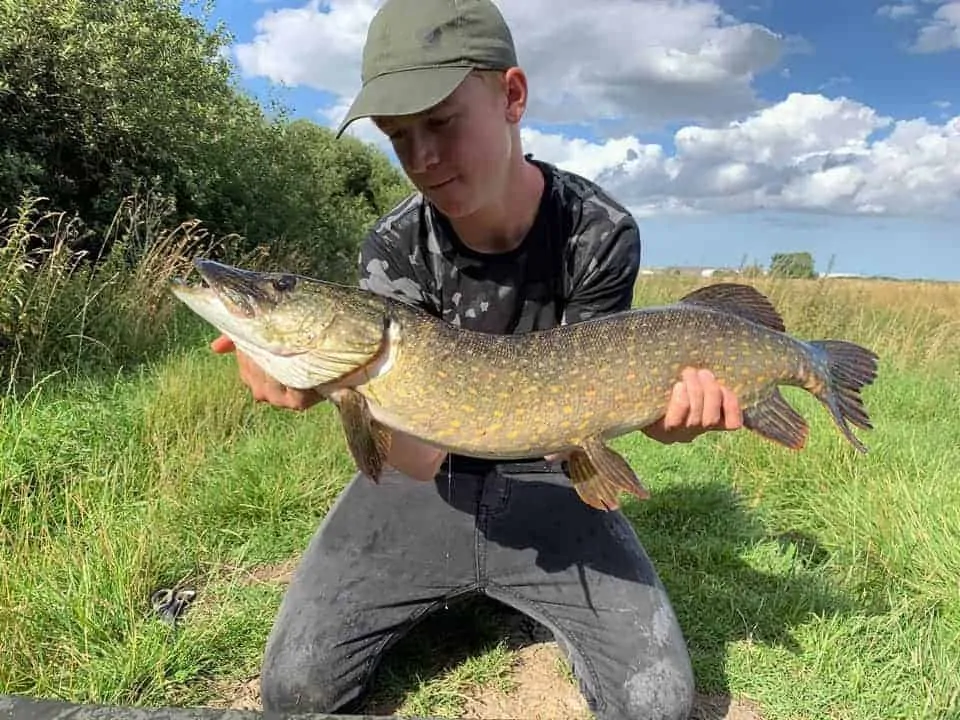
Especially when float or bobber fishing for pike, you can actually stay rather mobile and move around to fish different swims and spots.
Maybe you catch a pike or two in one location and then do not get any more action. Or perhaps, the spot you’ve targeted just won’t produce any bites that day.
Rather than giving up and heading home, move to the next spot and try your luck there. A big pike may be waiting for you in that spot!
39. Cut your dead bait in half
Sometimes, using a whole dead fish is too much, even for a pike. On some days, they prefer a smaller bite that they can instantly swallow.
Try cutting your dead bait in half and use both the upper and lower half as bait.
A cut fish also spreads more scent underwater, which can make all the difference during a slower session.
Some of the best dead baits for pike include:
- mackerel
- herring
- smelt
- lamprey
- shiners
- suckers
40. Use a big enough float for live bait
A common mistake that beginners make far too often is that they put on a float that is too light for the live bait they are using.
If the bait gets too lively or mobile, it will simply pull down the float, which in turn messes up your bite indication.
Now, the amount of grams on a predator float does not really say all that much, for example, a 20g float or bobber can handle a baitfish that weighs much more than 20 grams.
That weight indication is merely telling you how much weight you can put on your line in order to cock the float into position. So, do not focus too much on it when it comes to baitfish size vs float size.
Instead, simply use common sense and do some testing. If the baitfish manages to pull the float under, size up!
Helpful Equipment Tips for Pike Fishing
41. Use long nose pliers
Longnose pliers are the absolute best and most important tool when it comes to pike fishing.
These pliers will ensure a safe and easy unhooking of the fish, no matter how deep it is hooked. You will both be able to reach the hooks and get a firm grip on them to pull them out.
Using pliers will save you a lot of pain and blood. Trust me, I’ve been there!
Whoever came up with the idea of using this tool for big pike mouths should get a medal, for sure! Find the best pliers for pike mouths on Amazon here.
42. Get a jaw spreader
Pike have extremely powerful jaws and trying to open up that mouth with your hands can both be very difficult and dangerous.
A jaw spreader is a strong enough tool to separate the pike’s jaws, and, perhaps even more importantly, to keep them apart so that you can unhook the fish safely and smoothly.
43. Don’t forget to bring a wire cutter
If a pike is hooked too deeply, you sometimes have to cut your wire trace in order to be able to put your remaining end tackle aside and solely focus on those hooks in the pike’s mouth.
A wire cutter can assist you in such a situation, cutting your trace swiftly and easily.
44. Use armor gloves to handle pike mouths
Those teeth are no joke! A pike’s mouth is filled with up to 700 razor-sharp teeth and they can certainly cause major damage to your hands and fingers.
Armor gloves, or steel gloves, do an excellent job of protecting your hands both during a chin grip and when handling the fish on land.
You can read all about the northern pike’s amazing set of teeth in this article I wrote on the subject: Northern Pike Teeth (Facts And Pictures)
45. Use a weigh sling
Weighing your pike in a sling or a big Ikea bag (one of those blue ones) is much better than hanging the fish right onto the scale.
A big sling or bag will fit even the biggest and fattest of pike and makes weighing such a fish much easier as well.
46. Get a big enough fishing scale
I have seen many scales reaching their maximum weight when a big pike has been caught.
That’s why it is crucial that you have a big enough scale. If you catch that giant northern pike, surely you will want to know its exact weight, don’t you?
A digital scale that can weigh a maximum weight of 50lb is definitely not inappropriate for pike fishing, go for it! If you want to get a really reliable and accurate fishing scale, you can find one on Amazon here.
47. Bring a hand towel
Pike are called snot rockets for a reason! They can be extremely slimy and handling them will leave a lot of that slime on your hands.
Washing it off in the water will do only so much, which is why you should always have a hand towel with you when fishing for pike. It makes handling your gear after a catch a lot easier.
48. Make sure your camera has a self-timer
If you are fishing by yourself, you will want to take a picture of that big old pike when you get it.
But trying to take a good photo while holding up a long and heavy fish is anything but easy. Luckily, many modern cameras and mobiles have a self-timer in them. Make sure you have one of those!
49. Do not use a lip grip
Never use a lip grip to land or weigh your fish. It is a rather cruel tool that pierces the pike’s lower lip and can cause serious damage and scars.
Weighing a heavy pike using a lip grip also puts way too much pressure on the fish’s lip.
Instead, use a net for landing the fish and a big bag or a sling, as well as a proper fishing scale in order to weigh it.
50. Bring a bottle of champagne
If you are going to implement some or all of the tips mentioned in this article, you will soon be catching big pike, and one of those may very well be a real trophy fish.
If and when that fish comes along and you can actually land it, you will want to properly celebrate it.
Make sure to always carry a little bottle of champagne in your bag in order to be ready for that pike of a lifetime!

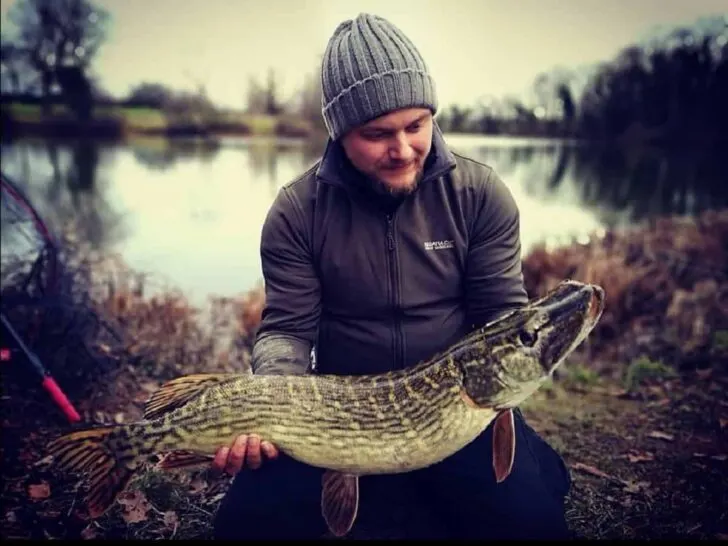
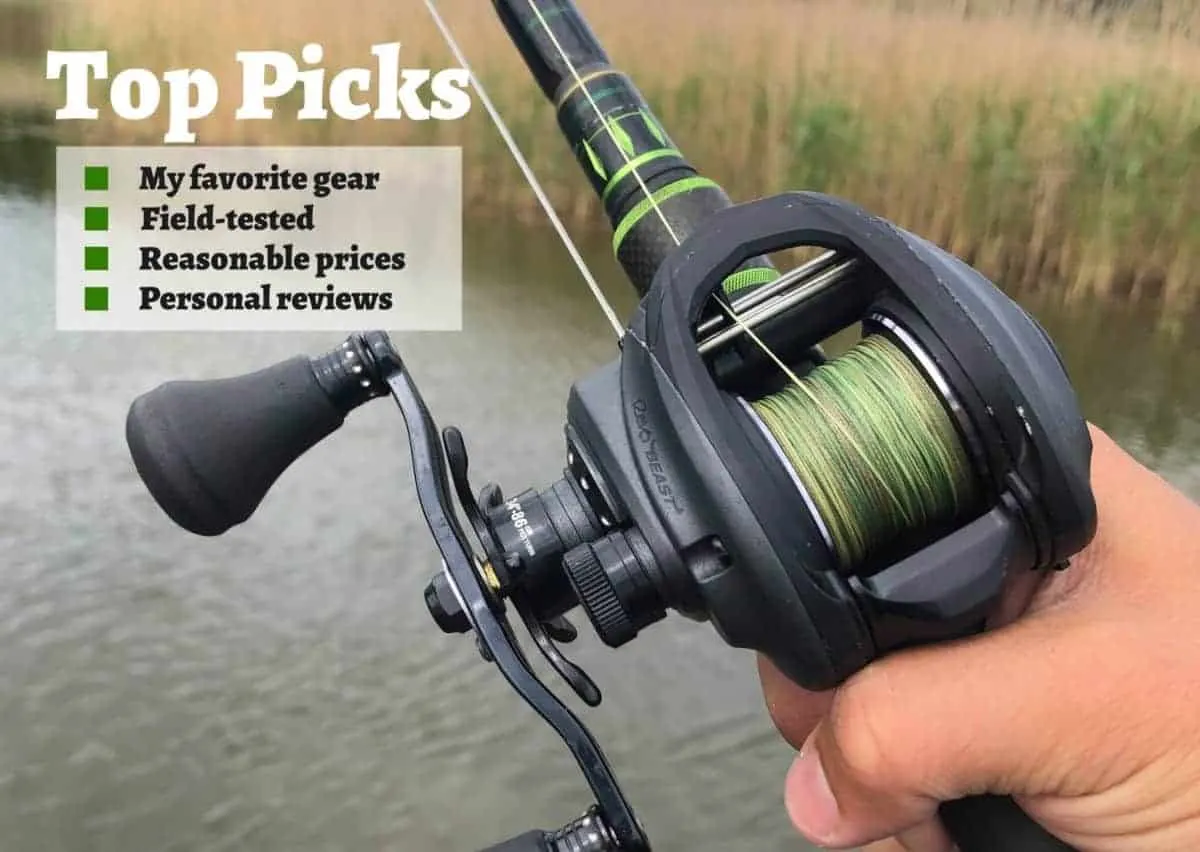
Many good advice, especially for the beginner.
The question of live or dead bait when angling for pike or other predators is an ethical one. However, if we just discuss the efficacy of live versus dead baits – which one do you usually feel more confident using?